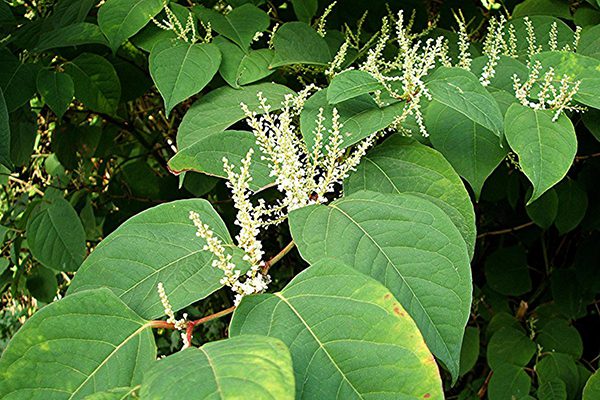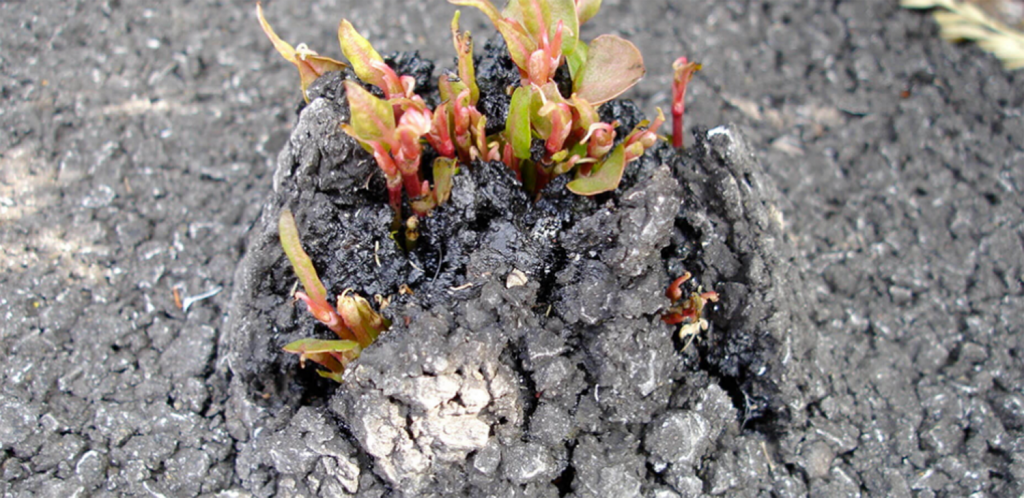What is Japanese Knotweed?
Japanese knotweed is an invasive species of plant that was brought over to the UK in the late 1840’s, it was sold to Kew Royal Botanical Gardens and in the coming years became commercially available to the general public. It gradually began to spread across the UK, and it is now believed an infestation of the plant can be found every 10km squared. Experts have estimated it costs the UK £166 million annually to keep under control, by means of destroying it or trying to hinder its spread.
It is a plant that is very hard to kill and keep under control, it grows very rapidly and is immune to being cut down as it will just grow back from very small amounts of plant material. It has no natural predators in the UK so is left to grow unhindered. Another problem is that it has a deep and vast underground roots system. The plant grows so aggressively that it is known for being able to grow through cracks in hard materials such as, tarmac, concreate, brick wall and drainage systems; weakening any cracks that were already present.
Devaluation of property prices across the UK is another factor, analysis calculates that on average it knocks 10% off the value of a property with it, based on the average house price this would be £23,530! However, the percentage of devaluation could be higher in some cases. Analysis suggests it affects 5% of property in the UK which would be around 1,450,000 homes, bringing the total deduction to about £34.12bn.

Japanese Knotweed and The Law
Due to it being an invasive species, the UK law deems it as a controlled plant under the Wildlife and Countryside Act 1981 section 114 (2) (WCA 1981). It is not illegal to have Japanese Knotweed growing on your property. However, this is a different story if you don’t control the plant and you allow it to spread onto someone else land/property or in the wild for example by fly tipping. Which could land you a CPN (community protection notice) for causing a nuisance. Government guidance on preventing the spread Japanese Knotweed is available on their website.
The main legislation that relates to Japanese knotweed is the Environmental Protection Act 1990 (EPA 1990) and the Wildlife and Countryside Act 1981 (WCA 1981). The EPA lists Japanese Knotweed as ‘controlled waste’ and it discusses the appropriate methods of transporting, removing, and disposing of the plant. The act makes it an offence to get rid of any contaminated soil or plant material failure to do this in a controlled manner will lead to a large fine. So, to avoid this all procedures should be followed correctly when disposing of it. – Guidance on treatment and disposal.
The EPA is supported by the Wildlife and Countryside Act – which states that ‘if any person plants or otherwise causes growth in the wild of any plant which is included in Part II of Schedule 9, he shall be guilty of an offence’. Japanese Knotweed is classified as a Schedule 9 plant, meaning anyone breaking this offence may face a fine of £5000 and/or 6 months imprisonment, or 2 years and/or an unlimited fine or indictment.
Selling A Property With Japanese Knotweed
There is also legislation that is relevant to those buying or selling a property. When selling a property, a ‘TA6 Form’ must be completed when conveyancing your home. On the form is a question about Japanese Knotweed asking if it is present or within 3 meters of the perimeter. The seller must be certain none is present, and this also counts even if it is not visible above ground and only present at the rhizome (root level).
Failure to answer this correctly can lead to the seller or the property surveyor they used being prosecuted and fined up to £2,500, or potentially more if they have purposefully tried to conceal the infestation. Some of this legislation seems very harsh, but it demonstrates the UK governments stance on the severity of the plant and how they’re trying to control the spread of it.

Removal Methods
You can try to remove Japanese Knotweed yourself however there are a lot of obstacles in the way, it is an extremely difficult process, and it requires permits for transporting and disposal. It can be very difficult to remove every trace of it and due to the nature of Japanese Knotweed the tiniest fragment can allow a new growth.
If you’re selling your home, you need a treatment plan that has an insurance backed guaranteed so doing the treatment yourself wouldn’t work. You can also try methods like injecting or spraying with glyphosate-based weed killer however this type of treatment requires rounds of treatment every season over 3-5 years in order to completely kill the plant. So not really a viable option if you’re looking to sell quickly.
For the most part it is best to have a professional treat the infestation as they are trained in this area and also have access to higher grade weed killers which can get the job done a little quicker. They will also have the correct permits to transport and then dispose of the waste Japanese Knotweed.
Other removal methods include burying it at a depth of 5 meters and surround the plant material in a root barrier membrane which will contain the plant and it will not be able to spread. Another bonus of using professionals to treat an infestation is that most treatment plans come with a 10-year insurance backed guarantee as standard meaning if the plant does manage to grow back in that time they will come back and treat it again. This is also essential if you are trying to sell a property and the knotweed is still present.
So How Can You Claim?
If you find Japanese Knotweed on your property and it has spread from a neighbouring property or land, then you could be eligible to make a claim. For example, a homeowner made a claim against Network rail and was awarded £15,000. Another group of homeowners in the Amman Valley in South Wales won a compensation claim for damages totalling £42,500. Between 2011-2019 Network Rail has received over 6,000 complaints and there have been 37 closed cases the total pay-out of these exceeded £500,000!
You could also have grounds for a claim if you have discovered Japanese Knotweed on a property, after you have purchased recently and after a surveyor or homeowner has failed to mention it on a TA6 property form. You would be able to claim to pay for the treatment and removal. However, if it was mentioned on a TA6 form then you will be liable for the cost of its removal.
It has been estimated that Japanese Knotweed affects up to 1.45 million homes across the UK which is roughly 5% of properties, this means there could be a good chance of a buyer being presented a home with an infestation especially where Japanese Knotweed is prevalent. Sellers trying to cover up the presence of Japanese Knotweed is a common occurrence as it can knock up to 15% of value off your home and it is estimated that 75% of buyers would withdraw from a purchase if they knew it was present on the property.
Previously it used to be very hard to be granted a mortgage on a property with Japanese Knotweed present, now it is a little easier, but lenders will be precautious, and you will have to prove to the bank that the money is safe with you.
They use a four-tier system as a basis to rate the risk of Japanese Knotweed this has been created by RICS (Royal Institution of Chartered Surveyors) which is as follows – category 4 being the worst and 1 being the least:
Category 4
Japanese Knotweed is within 7 metres of a habitable space, conservatory and/or garage, either within the boundaries of this property or in a neighbouring property or space.
And/or
Japanese Knotweed is causing serious damage to outbuildings, associated structures, drains, paths, boundary walls and fences and so on.
Category 3
Although Japanese Knotweed is present within the boundaries of the property, it is more than 7 metres from a habitable space, conservatory, and/or garage. If there is damage to outbuildings, associated structures, paths and boundary walls and fences, it is minor.
Category 2
Japanese Knotweed was not seen within the boundaries of this property, but it was seen on a neighbouring property or land. Here, it was within 7 metres of the boundary, but more than 7 metres away from habitable spaces, conservatory and/or garage of the subject property.
Category 1
Japanese Knotweed was not seen on this property, but it can be seen on a neighbouring property or land where it was more than 7 metres away from the boundary.
However, these categories are RICS own ones and do not necessarily reflect all lenders’ stance on Japanese Knotweed infestations on a property, so in some cases you may still be declined a mortgage. However, the majority of lenders tend to follow the RICS guidance very closely on this.
How can Courmacs Legal Ltd. help you
If you think that you may have seen Japanese Knotweed or you’re unsure get in touch and we can help you identify whether you have an infestation.
If it turns out, you have an infestation, and it has spread onto your property from a neighbouring property then you could be eligible for compensation as well as having the management plan paid for. If you have just bought a home and it was missed by a surveyor and it was missed by the previous owners on a TA6 form, then you could also be eligible. If you’d like any more information or to discuss further, you can get in touch and start your No Win No Fee claim today.



